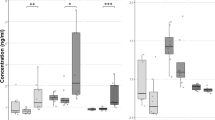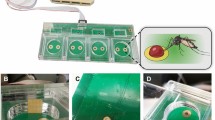Abstract
METHODS of estimating insect blood volume depend either on haemocyte counts before and after an injection of a measured volume of saline or on the dilution of amaranth dye by the haemolymph1. The latter method has been recommended for repeatable and consistent results with locusts2. Neither method, however, is likely to be practical for experiments with small insects, for example, the housefly, because the volume of liquid used for dilution (0.1–0.2 µl.) is too small to be administered with accuracy.
This is a preview of subscription content, access via your institution
Access options
Subscribe to this journal
Receive 51 print issues and online access
$199.00 per year
only $3.90 per issue
Buy this article
- Purchase on Springer Link
- Instant access to full article PDF
Prices may be subject to local taxes which are calculated during checkout
Similar content being viewed by others
References
Yeager, J. F., and Munson, S. C., Arthropoda, 1, 255 (1950).
Lee, R. M., J. Insect. Physiol., 6, 36 (1961).
Author information
Authors and Affiliations
Rights and permissions
About this article
Cite this article
SHATOURY, H. Micro-determination of Insect Blood Volume. Nature 211, 317–318 (1966). https://doi.org/10.1038/211317a0
Issue Date:
DOI: https://doi.org/10.1038/211317a0
This article is cited by
Comments
By submitting a comment you agree to abide by our Terms and Community Guidelines. If you find something abusive or that does not comply with our terms or guidelines please flag it as inappropriate.



